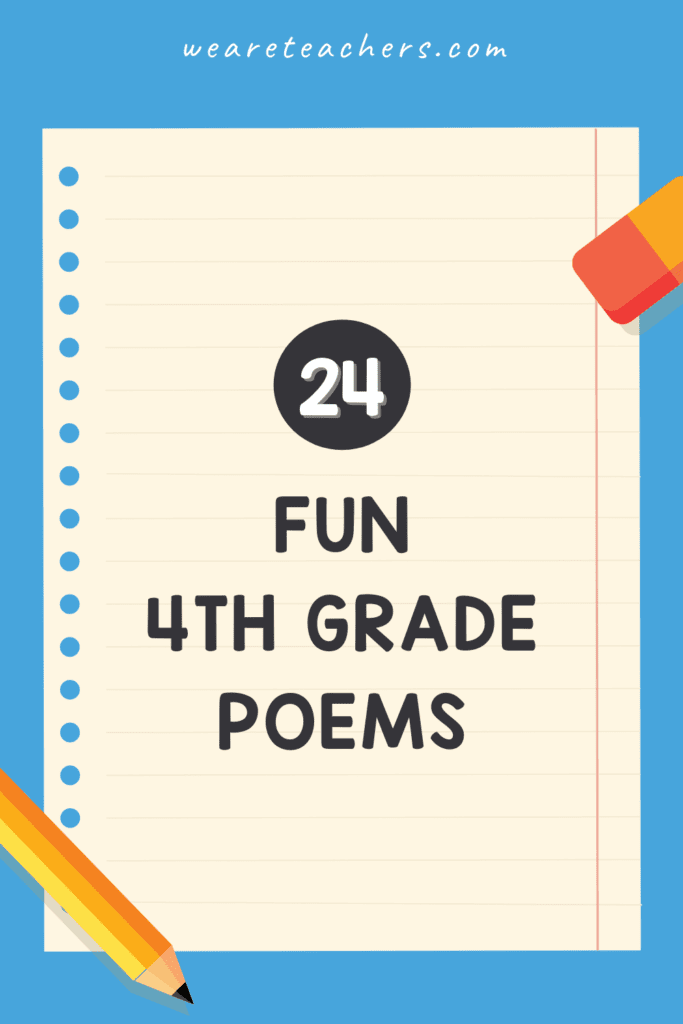Looking for the best poems for 4th graders? We’ve put together a great list of poetry you can use in your classroom lessons. This collection of poetry covers a wide variety of topics and ranges from simple sweetness to more complex prose. With options for different reading levels, you’ll find something for every student!
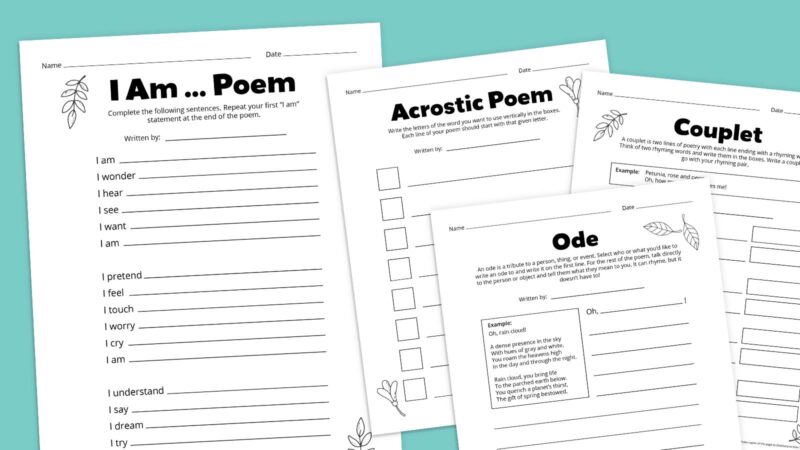
FREE PRINTABLE
Free Poetry Worksheet Bundle
Grab our poetry worksheet bundle to pair with your poetry unit and make teaching poetry fun and simple.
“You should try this little writing trick.”
Themes: Creativity, humor, writing process
Literary devices: Rhyme, repetition, tone, meta-poetry
This fun, self-aware poem takes a lighthearted look at the challenge of writing poetry, offering a clever “trick” to keep the words flowing. It’s a great way to get students thinking about how poems are put together while making the writing process feel approachable and fun.
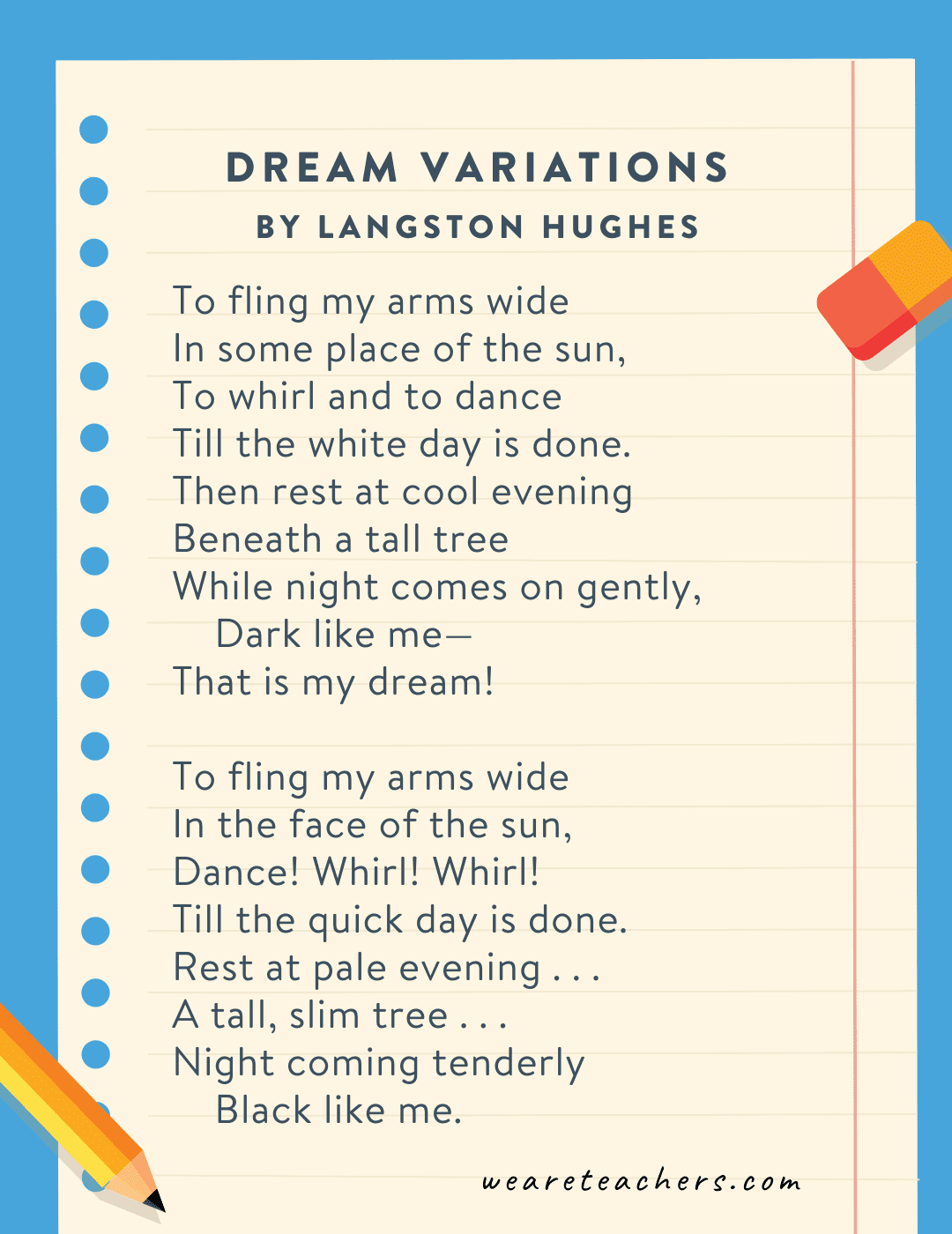
“To fling my arms wide in some place of the sun …”
Themes: Race, self-image, hope
Literary devices: Imagery, allusion, tone
This beautiful, rhythmic poem captures the speaker’s dream of joy and freedom, using striking images of light and darkness to highlight different realities. It’s a meaningful way to spark discussions about racial themes, the Harlem Renaissance, and how poetry can express deep emotions through structure and imagery.
“… not pasted on some other place.”
Themes: Humor, absurdity, the human body
Literary devices: Imagery, rhyme, extended metaphor
This whimsical poem uses silly scenarios and fun imagery to get students thinking about perspective and appreciating everyday things in a new way. It’s an ideal pick for exploring rhyme and rhythm while also sparking creativity and laughter in the classroom.
“Why do they say money grows on trees?”
Themes: Money, curiosity, questioning
Literary devices: Metaphor, imagery, symbolism
This clever poem explores the well-known saying “money doesn’t grow on trees” through an engaging conversation. It’s useful (and very timely!) for teaching figurative language, particularly idioms and metaphors, as well as sparking discussions about financial literacy and the value of money.
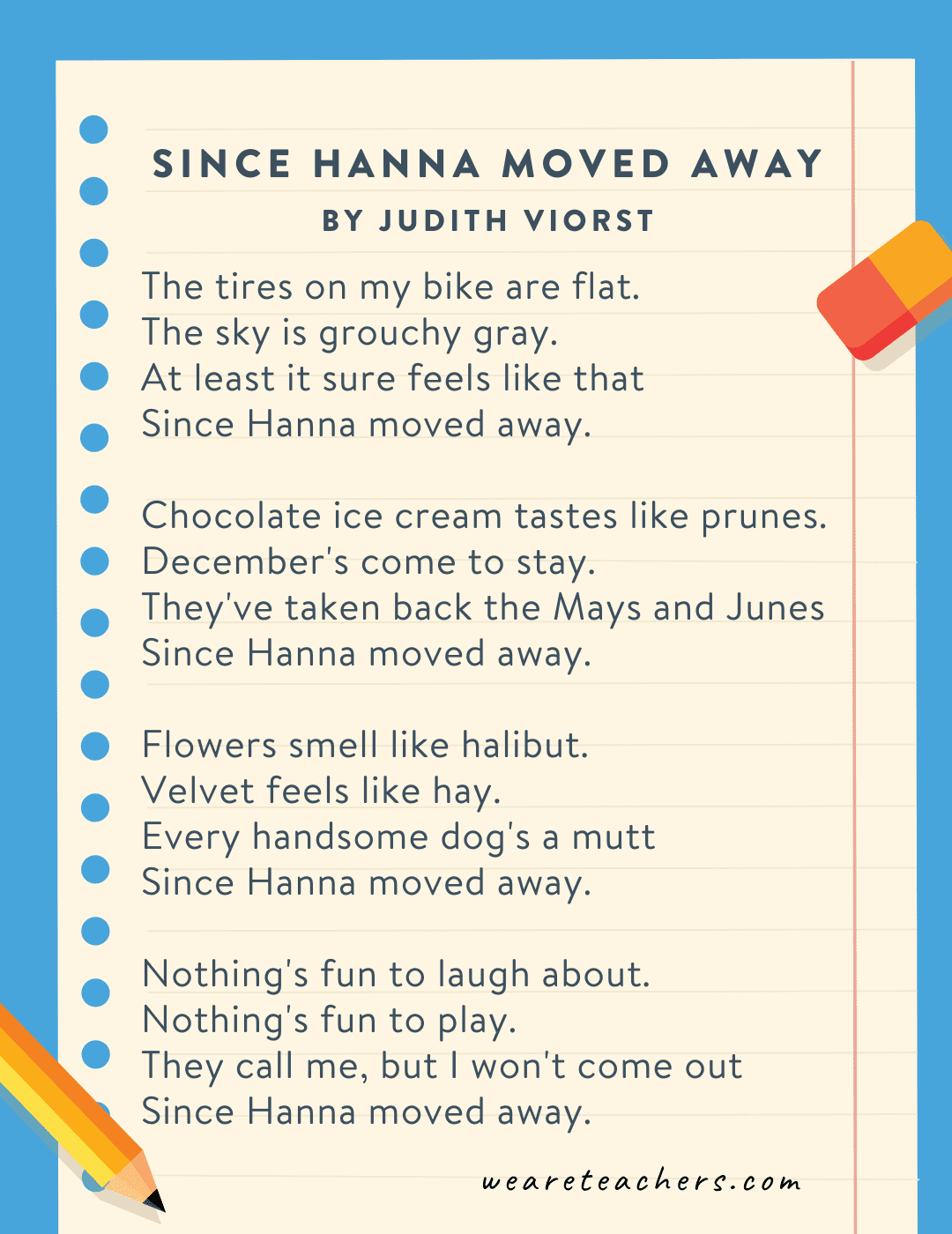
“The tires on my bike are flat.”
Themes: Loss, change, sadness in friendship
Literary devices: Rhyme, repetition, contrast, simile
This poignant poem captures the sadness of losing a close friend, using simple language and relatable details to express the emotional weight of change. It’s an excellent choice for discussing how poetry can convey deep feelings through everyday experiences and for helping students connect literature to their own lives.
“The other night ’bout two o’clock, or maybe it was three …”
Themes: Childhood fears, comfort, bravery
Literary devices: Rhyme, rhythm, imagery, tone
This nostalgic poem captures a child’s nighttime fears and the comfort of feeling protected by a parent. It’s a solid option for discussing how poetry can reflect childhood experiences, as well as exploring rhyme, rhythm, and how tone shifts from fear to reassurance.
7. The Fair by Vernon Witmer
“The car door opened / The first thing I saw / Was an explosion of balloons …”
Themes: Excitement, nostalgia, sensory experiences
Literary devices: Imagery, sensory details, free verse
This poem immerses readers in the sights, sounds, and feelings of visiting a fair, making it an engaging example of using vivid sensory details in writing. It’s perfect for inspiring students to write about their own experiences with rich descriptions.
“I noticed the mockingbirds first …”
Themes: Nature, observation, appreciation
Literary devices: Imagery, personification, symbolism
This reflective poem encourages readers to notice the small wonders of nature, using detailed descriptions and subtle symbolism. It’s a great way to introduce students to nature poetry and the idea of finding deeper meaning in everyday observations.
9. New Math by Nikki Grimes

“Up till now, the math of my life has been pretty simple …”
Themes: Change, growing up, resilience
Literary devices: Metaphor, extended metaphor, tone
This poem cleverly compares life’s ups and downs to math, making it a relatable and engaging way to discuss how figurative language can express emotions. It’s ideal for connecting literature to students’ own experiences and exploring how poetry can use everyday concepts in creative ways.
“We suffer through blinding equatorial heat …”
Themes: Survival, nature, resilience, connection
Literary devices: Imagery, contrast, symbolism
This poem vividly describes the endurance of tree sparrows in harsh conditions, drawing parallels to human resilience. It’s a strong choice for discussions about symbolism in poetry, the relationship between humans and nature, and how writers use contrast to create meaning.
“No one can tell me / Nobody knows / Where the wind comes from / Where the wind goes.”
Themes: Curiosity, wonder, nature
Literary devices: Rhyme, repetition, personification
This charming poem captures a child’s curiosity about the wind, blending simple language with deep wonder. It’s a great way to introduce young students to rhyme and rhythm while encouraging discussions about imagination and the natural world.
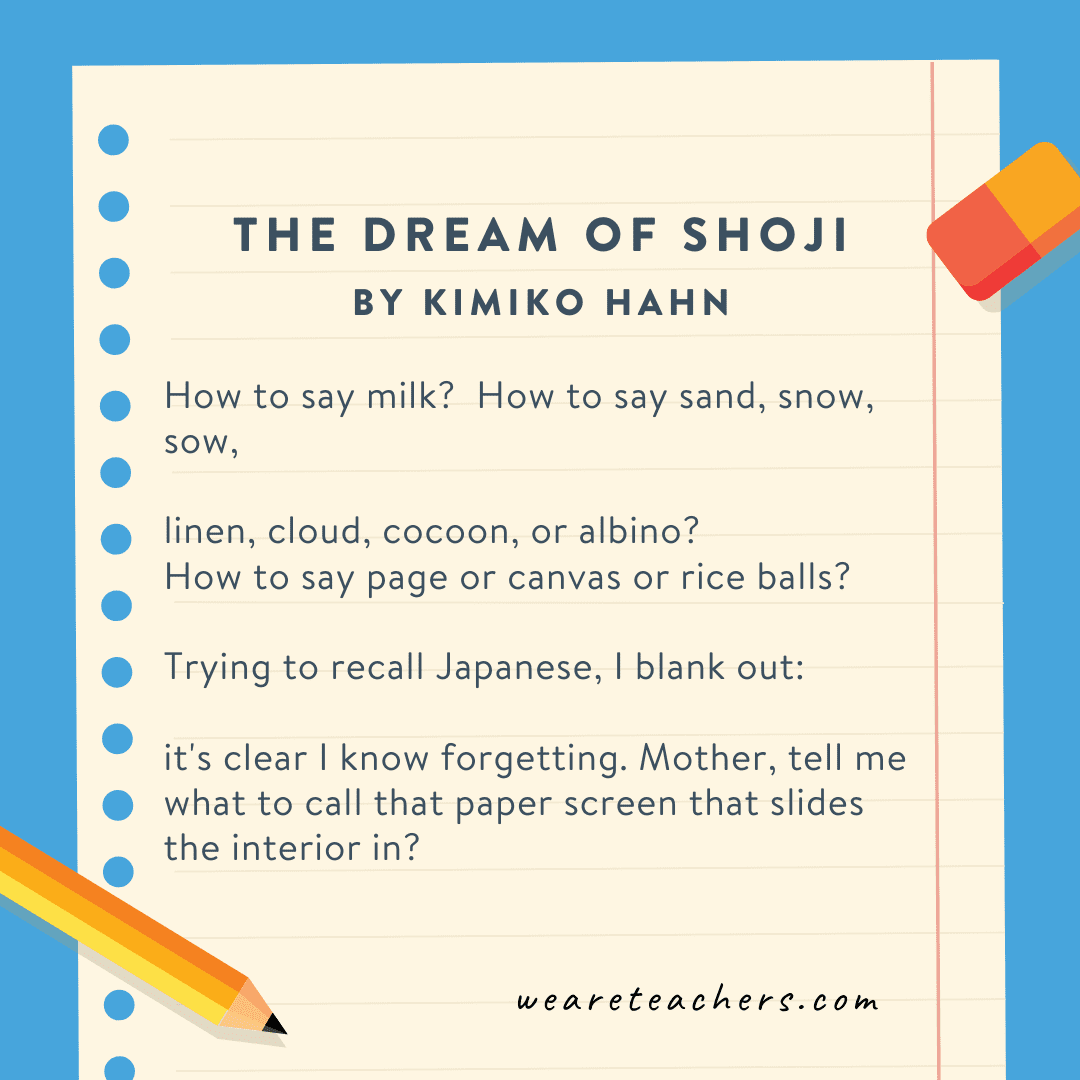
“How to say milk?”
Themes: Language, identity, cultural connection
Literary devices: Imagery, symbolism, free verse
This thought-provoking poem explores language as a bridge between identity and heritage. It’s an excellent choice for discussions on bilingualism, cultural experiences, and how poetry can capture personal struggles with language and belonging.
“Under this loop of honeysuckle …”
Themes: Nature, transformation, life cycles
Literary devices: Imagery, personification, contrast
This detailed poem brings a caterpillar to life with vivid descriptions, making it perfect for studying imagery and personification. It’s also an effective way to discuss themes of transformation and the beauty of small, unnoticed creatures.
“It was our third-grade field trip to the Dinosaur Exhibit …”
Themes: Humor, exaggeration, storytelling
Literary devices: Hyperbole, narrative structure, rhyme
This hilarious, over-the-top poem is a perfect example of hyperbole in action. It’s excellent for engaging reluctant readers, sparking creative writing, and showing how storytelling techniques can make poetry fun and engaging.

“His tongue shorn, father confuses snacks for snacks, kitchen for chicken …”
Themes: Immigration, language, generational divide
Literary devices: Metaphor, imagery, tone
This moving poem explores the complexities of immigration and language barriers, particularly between generations. It’s a solid choice for discussions about metaphor, identity, and how poetry can capture deep emotions and real-life struggles in just a few lines.
16. Spring Break by April Halprin Wayland
“The best clouds in the business are right above me right now.”
Themes: Relaxation, nature, appreciation of the moment
Literary devices: Imagery, personification, conversational tone
This poem captures the carefree joy of spring break with playful, vivid descriptions of the sky and surroundings. It’s great for exploring imagery and personification while encouraging students to reflect on their own favorite moments of rest and relaxation.
17. Tending by Elizabeth Alexander
“In the pull-out bed with my brother …”
Themes: Family, love, memory, care
Literary devices: Sensory details, free verse, tone
This touching poem reflects on a childhood moment of closeness between siblings, highlighting themes of love and caretaking. It’s a wonderful piece for discussing the role of small, everyday moments in poetry and how sensory details bring memories to life.
18. Snowball by Shel Silverstein
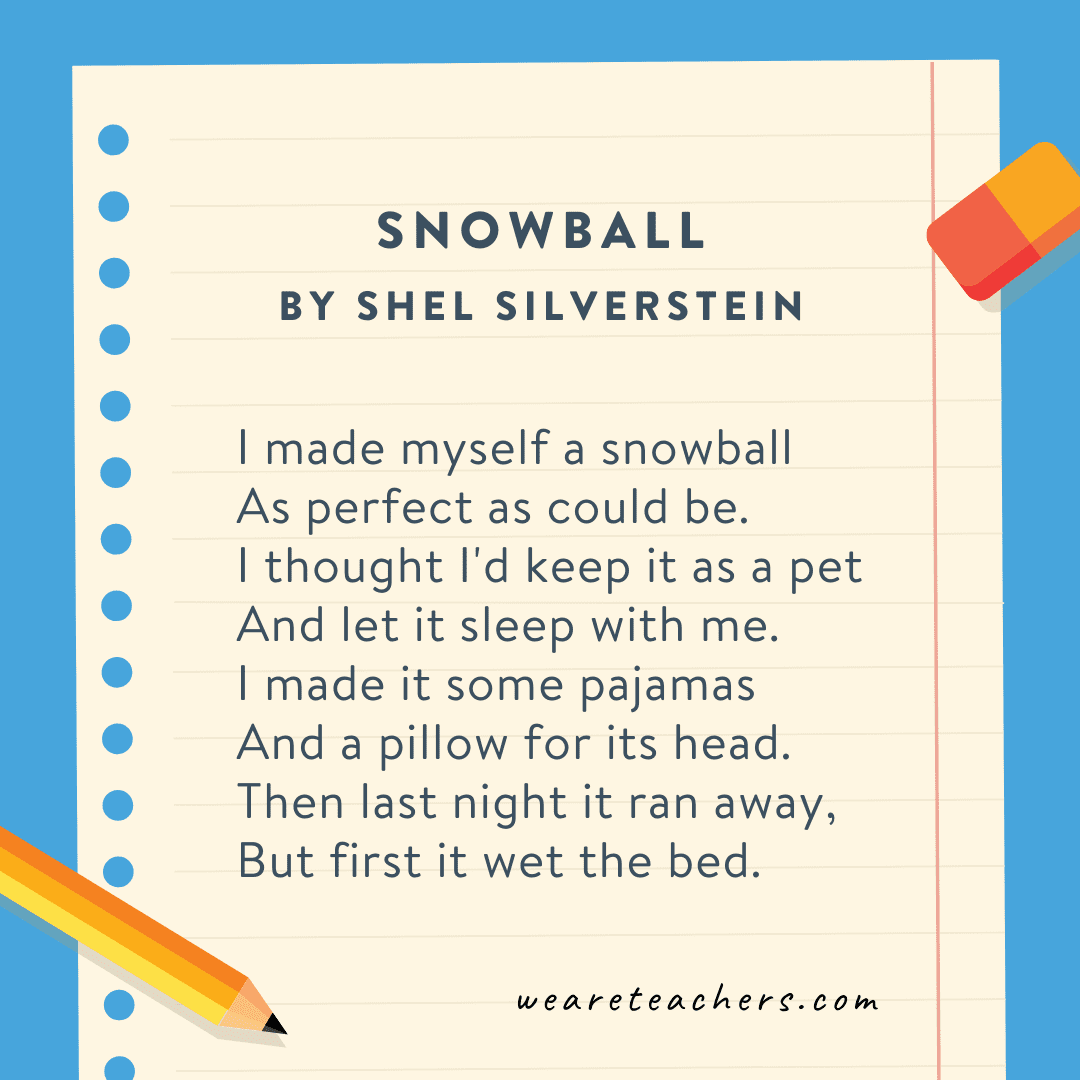
“I made myself a snowball …”
Themes: Humor, nature, impermanence
Literary devices: Rhyme, irony, personification
With its classic Silverstein humor and surprise ending, this poem is a fun way to introduce rhyme and irony. It’s also a great conversation starter about how poetry can use simple language and playful ideas to make an impact.
“In the vast open field …”
Themes: Memory, appreciation, passing time
Literary devices: Imagery, tone, symbolism
This reflective poem invites readers to hold onto fleeting moments, making it a solid choice for discussing themes of memory and time. It also works well for exploring how poetry can create mood and emotion through descriptive imagery.
“Come, my little one, with me!”
Themes: Dreams, imagination, bedtime
Literary devices: Rhyme, repetition, personification
This dreamy poem invites young readers on a magical journey into sleep. It’s perfect for exploring rhythm and rhyme while sparking discussions about imagination and the comforting power of bedtime stories and lullabies.
21. Crows by Marilyn Nelson
“What if to taste and see, to notice things …”
Themes: Observation, nature, perception
Literary devices: Imagery, metaphor, rhetorical questioning
This reflective poem encourages readers to slow down and truly observe the world, using crows as a lens for noticing life’s details. It’s a great piece for discussing mindfulness, the power of perspective, and how poetry can shift how we see everyday things.
“One ran, her nose to the ground …”
Themes: Mystery, nature, fleeting moments
Literary devices: Free verse, imagery, symbolism
This quiet, meditative poem captures a fleeting moment in nature, allowing space for interpretation and emotion. It’s perfect for discussing how poets use minimal language to evoke deep meaning and how nature can serve as a metaphor for the human experience.
“We all have the same little bones in our foot …”
Themes: Connection, identity, ancestry
Literary devices: Metaphor, repetition, free verse
This thought-provoking poem highlights our shared humanity by focusing on the simple act of standing. It’s an excellent choice for exploring themes of kinship and unity while showing how poets use everyday actions to express larger ideas about identity and belonging.
24. Amphibians by Joseph O. Legaspi
“Immigrants leave their land, hardening in the sea.”
Themes: Immigration, transformation, adaptation
Literary devices: Metaphor, symbolism, concise imagery
This striking poem compares immigrants to amphibians, exploring themes of resilience and adaptation. It’s a great discussion piece for exploring metaphor in poetry and how writers use natural imagery to express complex human experiences.
Get my free printable poetry worksheet bundle!

Are you ready to bring these activities to your classroom? Click the button below to receive our poetry worksheet bundle and get started!
Love these 4th grade poems? Be sure to subscribe to our newsletters so you can find out when more articles like this are posted.
